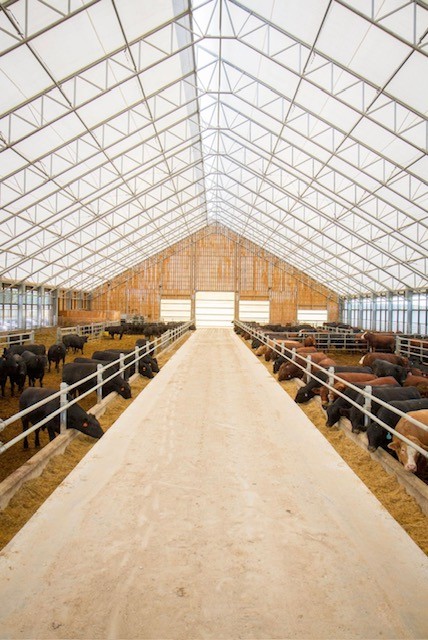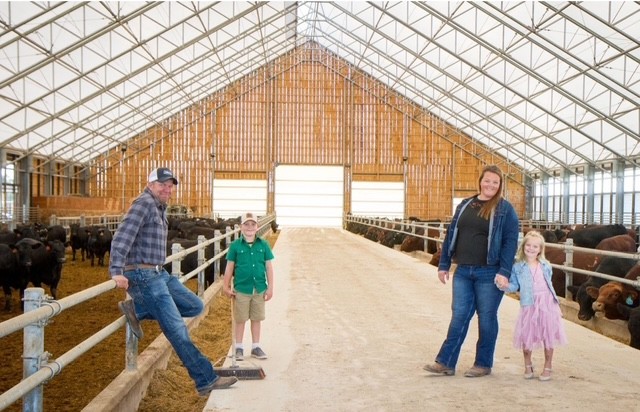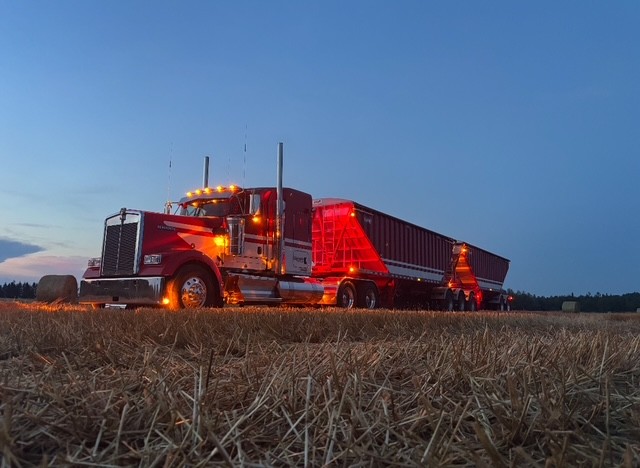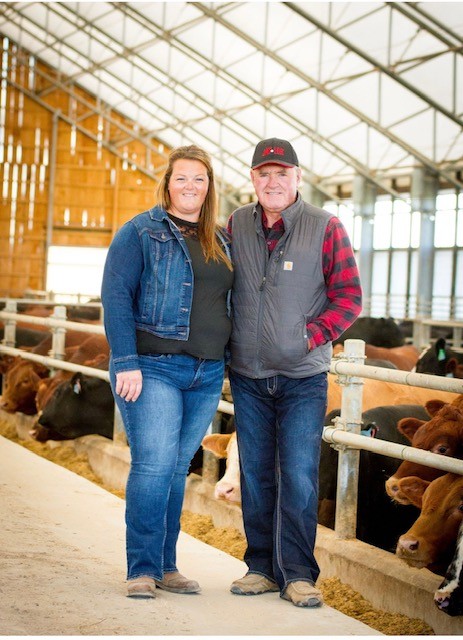 Taray Farms is a multi-generational farm located outside of Shelburne, ON, in Amaranth Township. On the farm you will find Ray and Tara McCabe alongside their daughter, Brandi McCabe, her husband Gord Curie, and their kids, Archie and Charlie.
Taray Farms is a multi-generational farm located outside of Shelburne, ON, in Amaranth Township. On the farm you will find Ray and Tara McCabe alongside their daughter, Brandi McCabe, her husband Gord Curie, and their kids, Archie and Charlie.
Brandi is the 3rd generation of McCabes on the farm. She is one of four daughters, with all the other sisters living close by. Brandi’s sisters are not active on the farm, but they support Brandi by caring for the kids in busy seasons or offering rides to and from the fields. They are always willing to help where they can.
Taray Farms is a century farm, started back in the early 50s when Ross McCabe was milking cattle, selling cream and producing spring cereals for feed. As he grew his operation, Ross wanted to ensure he didn’t put ‘all his eggs in one basket.’ He diversified by purchasing land and a barn close to home, allowing him to start a beef herd in 1965. In 1977 Ray McCabe – the second generation – came home to join the farm. There was the need for a change to the structure of the business at this point, and the family decided that they should buy and sell cattle weekly, buying in yearlings and selling fat cattle.
The late 70s and early 80s came, and high interest rates hit the farm hard. The father-son team needed to mitigate risk, a challenge which pushed them to reduce feed costs by pasturing their cattle. Ross and Ray used every land resource they could find until they had cattle at home on pasture, as well as on pastures in Chesley, Paisley and Tara, ON. They did weekly pasture runs to ensure the health of their spread-out herd, a tradition that continued for many years. Brandi recalls that she and her sisters loved the job of going with their grandpa and dad to check pastures as it always meant an ice cream date on the way there and back!
As Ray became more involved in the daily decisions of the farm and started to invest in land, the time and headache of pasturing cattle away from home became too much. The cattle were moved back to Shelburne and began to be finished on feed in early 2000. This was also around the same time the girls decided to start their 4-H career and showed more interest in the farm rather than just the ice cream dates!
In 2009 Brandi went to Ridgetown College where she studied for her Diploma in Agriculture. Wanting to continue her education, Brandi took the opportunity to proceed to Olds Alberta where she completed her Bachelor of Applied Agricultual Science. Upon completion, Brandi still wasn’t ready to take on farm duties, so she explored working at a local grain elevator, learning from local farmers and developing her knowledge. In 2015, Brandi decided it was time to head home and become part of the family business, purchasing her first farm with the help of her parents.
Today the farm operations consist of 1400 acres of land with a cropping rotation of corn, soybeans, wheat and potatoes. This rotation was not always in place: it wasn’t until 2012 when the family started growing their own corn to feed the cattle. Brandi says she “can remember it like yesterday; corn prices were crazy high and we were buying in truck loads of corn to finish cattle.”
Working in the seed industry, she knew they could grow low-heat unit corn in their area as genetics and traits had changed over the years. The older generation however, was always told they couldn’t grow corn in their ‘neck of the woods’. It took time, but Brandi and her husband convinced her dad that they should try it. They hired custom operators to plant and harvest their first corn crop. Brandi says, “it wasn’t a month post-harvest that there was a corn planter and header purchased and we have been growing corn ever since.” Canola also used to be a big crop in their rotation, but as Brandi became more actively involved in doing all the spraying and combining she says she knew canola and her “didn’t see eye to eye”, so they swapped out canola acres for soybeans.
A couple years ago the family decided it was time to yet again make some operational changes after experiencing challenges when competing with larger operations on buying land locally. They built a 120′ x 306′ free span Britespan barn, an investment Brandi says she hopes to look back on in 20 years and feel was the best thing she ever did.
They are now feeding approximately 1000 head between two old bank barns and the new barn. They are buying in cattle mostly sourced from the west at 725 to 1000 lbs and finishing them to 1600 lbs or greater. They feed a high corn diet; corn silage, high moisture corn, dry corn, corn gluten (a byproduct of corn) and enough hay for “scratch.” All the feed is self-grown or locally sourced. They didn’t get to that point overnight: Brandi notes that it was all the investments and forward thinking of the 1st and 2nd generations that did it. Without Ross and Ray buying land at some of the toughest and scariest times of their lives, they wouldn’t have the land to build on or the ability to grow their own crops to feed cattle. Brandi considers herself lucky that their land base is close to home too. It allows them to spread the beef manure back on their land, which is beneficial for building soil back up after removing the crop and also adds value to the next crop.
Brandi really stressed that the farm is successful today because of the history behind it, the generational support, and the smart decisions that Ross and Ray made in the past. Brandi hopes that the decisions she makes today and tomorrow can leave as much of an impact as those that her father and grandfather have. They are why she makes the farming decisions she does today – she says she learned from them and grew through their choices. 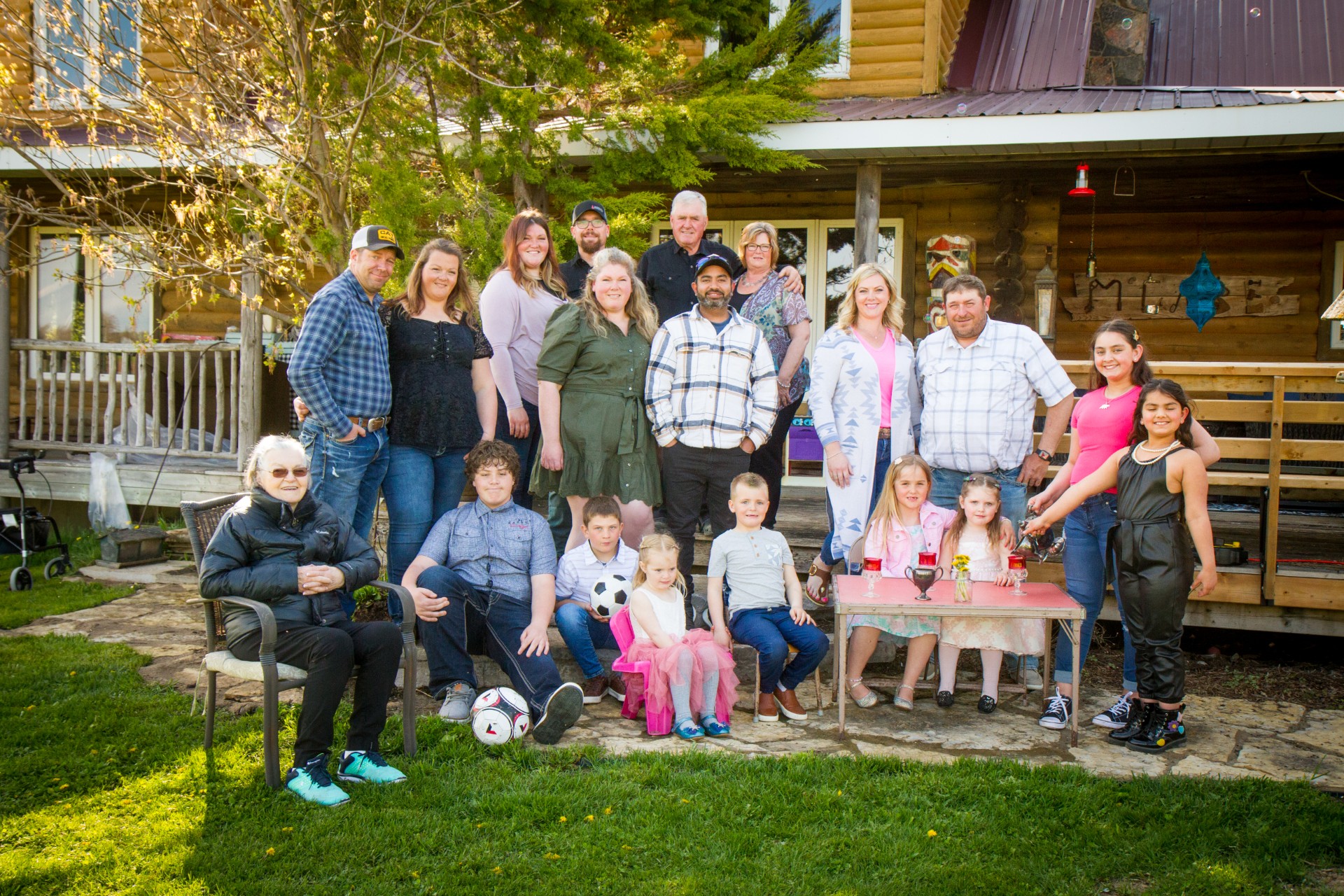
Soil health is a very important aspect of the Taray operation. The McCabes continue to learn what their soil needs are, having tried many practices to improve soil health. They have removed the furrow plow from their operation and traded it in for a chisel plow, noting the deep soil loosening improves aeration, water infiltration and breaks up soil compaction and hard pan. They also try to do minimal tillage after having found no-till generally does not work for their heavier ground. Having said that, they do no-till seed most of their winter wheat into soybean stubble and have found that the practice fits into their operation amazingly well, allowing the soil to keep its structure and help reduce water erosion.
Cover crops are something the family continues to play with, frost seeding clover on wheat ground that will be going into corn the following year. The practice adds organic matter to the soil and also adds natural nitrogen for the crop to use. Brandi says when the cover crop has been worked in and planted, the ground is like walking on a cloud. Spreading manure is one of the biggest soil initiatives they use. Manure provides essential macro and micro-nutrients, adds organic matter, reduces soil erosion and improves soil structure leading to a healthier crop overall.
Technology and equipment on the farm are so rapidly changing that the McCabes feel it is important to do a lot of research before purchasing. Their first big purchase of technology was in 2015 when they planted their first corn crop ‘hands free’. They bought a GPS and never looked back, noting the overlap elimination and savings in time as well as fuel were remarkable.
In 2020, they rebuilt their six-row corn planter to include precision planting aspects and hydraulic downforce, and continue to want to improve the planter with furrow force. All planting and sprayer tractors, as well as the combine, have mapping capabilities so they can track yield and obtain data. The goal is to eventually use prescriptions and variable rate applications to reduce inputs and improve efficiency in the fields. In the barn they have scales on the cattle squeeze, enabling them to record and track cattle intakes and health. They also have a TMR with a scale for accurate feed mixing and are looking into programs to help tie in feed and cattle health to improve barn efficiencies.
The McCabes are constantly considering how they can manage risk on their farm. All three generations have experienced high interest rates (some much higher than others), high land values and a volatile cattle market. As a result, when making decisions on the farm they always consider the risk involved. As part of their risk management strategy, the McCabes own all their own equipment except for that involved in silage. This allows them to spray and plant their crops at the ideal time, not letting things get out of control (Brandi jokes that if they could control the weather, then they would be laughing). They both own and custom feed cattle, which helps mitigate market price swings. They went from selling cattle once per year to selling quarterly in an effort to hit different trending market highs. They take advantage of government programming such as OSCIA funding too, having applied to improve their corn planter and cattle handling facilities.
Brandi has served on the Dufferin Soil and Crop board of directors as Secretary and Treasurer for the past 10 years. She finds that sitting on a board keeps her aware of what’s going on in the area and also helps her to keep in touch with programs that are available. Both have been very beneficial to their business. She says they are also very lucky in the sense that her husband, Gord, used to be a full-time truck driver but has recently come home to help with the farm operation. This allows them to haul all their own commodities out when time and markets allow, although they are still working on getting him a livestock trailer to haul cattle.
Brandi sees an important trend in the farm: starting with her grandparents’ generation and continuing through to her own, sustainability, improvement of the operation for the next generation and making impactful decisions that help to grow the farm have been very important. Advice she’d give from one “young” farmer to another: listen to your elders – history always repeats itself in one way or another. Also, don’t be afraid to take chances as you don’t know till you try it.
Looking forward, Brandi hopes that her family can continue to expand and improve the land they have close to home – both environmentally and by looking at soil health. She wants to provide the next generation with the same opportunities the previous generations allowed her to have, and she wants to continue to be successful, learn and grow.
We would like to thank Brandi for taking the time to put this article together amidst the busy season of wheat harvest and other daily work. It’s a pleasure to hear about the progression of their farm and the generations who work together to make it so successful. Brandi has been an integral part of Dufferin County SCIA’s executive for many years, and we’re very pleased to highlight her family in this month’s Bulletin. Thank you Brandi!
